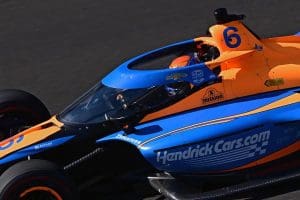DAYTONA BEACH, Fla. — Not too long ago, I stumbled upon a photo of the great Jim Clark, who wasn’t driving a Lotus-Ford but instead, was wheeling a Holman Moody Ford Fairlane during a 1967 NASCAR stop at Rockingham (N.C.) Speedway.
Clark, who had already won the Formula 1 title, started 24th and was credited with a 30th-place finish after completing 144 of 500 laps. It was an example of how during that era, drivers jumped excitedly from one branch of motorsports to another.
It wasn’t yet the age of mega-money in racing, which explains why we saw Clark at Rockingham and drivers such as Cale Yarborough and Lee Roy Yarbrough race Indy cars. A.J. Foyt wheeled a midget to victory in the Houston Astrodome not long after winning at Le Mans.
USAC ran a very competitive stock car series in which the Indy guys used to play on off weekends for some extra cash. And then, just as drivers started to seriously silo themselves off into individual specialties, came the original IROC series, which at first successfully matched drivers from a variety of racing disciplines.

At one time, the fields at USAC sprint car features were regularly dotted with guys who had raced in that year’s Indianapolis 500. USAC once ran a dirt, asphalt and road-course stock car series that was second only to NASCAR in terms of race dates, and like the sprint cars, boasted Indy legends such as Foyt and Roger McCluskey. Heck, even the legendary Jim Hurtubise went back to running modifieds in upstate New York as his Indy career wound down.
And let’s not forget the early days of the booming Can-Am series. Every grid featured drivers from NASCAR, American road racing, Indy, Formula 1 and the endurance sports car scene. To think that this once happened regularly is thrilling. To consider that it may be on the cusp of happening again leaves one with breathless anticipation.
Most of us know what happened next. Really big money, fueled by corporate sponsorship, began gushing into the sport. That led to the rise of driver contracts that tied drivers to a single arena, with its associated TV revenue. Emerson Fittipaldi’s experience in F-1 during the 1970s was a good example of that business plan.
The observation’s also been made that the pipeline for aspiring drivers has narrowed significantly since the days of Clark and Foyt, with today’s aspiring Indy stars getting their starts in formula cars.
And yet, you inevitably think back to what Mario Andretti said more than five decades ago: “If you can drive, you can drive.”
For several reasons, I really believe that’s coming true again. Let me cite why I think so, in large part because of the ongoing, dizzying changes at NASCAR during recent years.
I put the start of this trend in the 1990s, when open-wheel short trackers first started making inroads into NASCAR, and in the personages of Jeff Gordon and Tony Stewart, turned out to be really good racers. Had he lived, the late Kenny Irwin Jr. would likely have reinforced that reality, as well. A little later, Ryan Newman was recruited by Team Penske to run the NASCAR Cup Series, with former team president Don Miller, who discovered Newman, marveling about his “phenomenal car control.” Like Mario said, “If you can drive …”
Short tracks of all sorts have continued to produce NASCAR stars, with the Busch brothers just the tip of the iceberg. Kyle Larson has won in every type of race car he’s ever driven, become a Cup Series champion, and this year, will take on the Indianapolis 500 as part of the Memorial Day weekend doubleheader.
Someone at NASCAR headquarters figured out that interdisciplinary performances by international drivers could be very good for business. Hearken back to the 1970s, when NASCAR drivers and cars first appeared at Le Mans after its sanctioning group, the Automobile Club de l’Ouest, approached “Big Bill” France and asked him to import a couple of teams.
The ageless Hershel McGriff and his son, Doug, wheeled a driving-light-bedecked Dodge Charger, while Dick Brooks and Dick Hutcherson showed up with a Junie Donleavy-prepared Ford Torino, both cars also equipped with side mirrors.
The big NASCAR lumps, with drum brakes, had their issues trying to negotiate the Sarthe circuit at speed and neither finished the race.
But today is different. New drivers, even those with NASCAR ambitions, are starting to enter the sport through road racing as the Cup Series continues its slow pivot away from ovals.
Richard Petty’s grandson, Thad Moffitt, learned his chops through Trans-Am’s TA2 series, along with Brent Crews, utilizing a chassis that has clear similarities to what NASCAR runs outside the Cup series. The rise of NASCAR road racing has also seen an influx of international drivers trying stock cars.
Formula 1 champions Jenson Button and Kimi Rakkonen are examples. So is Juan Pablo Montoya, who went from F-1 to multiple NASCAR victories, while also winning two Indy 500s. Let’s not forget that Jimmie Johnson jumped from seven NASCAR titles to IndyCar, and did respectably well despite being in his 40s when he made the leap.
Which brings me to what I think is going to accelerate this new “If you can drive” credo in the future. To me, the NextGen Cup car will turn out to be one of the smartest things NASCAR has done in its recent history. Yes, it’s largely a spec race car with spec engines, dampers and tires. But look at what else it is. It has bigger, grippier tires on light-alloy wheels with single locking nuts. The transmission is sequential and at the rear wheels, Weissach axle-style. The NextGen car has enormous brake rotors and independent suspension. There’s an aero-friendly undertray.
What does this sound like? Something out of the German Touring Car Series, maybe? The Australian Supercars? Even TA2? Consciously or not, NASCAR has provided its lead division with a race car that has clear parallels to any number of international GT categories.
It looks, acts and feels like a road-circuit car. Have you noticed that Cup Series races on road courses are now slam-bang, ultra-competitive affairs, not unlike international touring car events? That’s why last year’s Garage 56 entry by Hendrick Motorsports at Le Mans was so important. NASCAR, unlike the 1970s, now has a car that’s a fully credible Le Mans competitor. It can run fast, do it at night, in the rain, and for 24 hours without breaking.
Consider the case of Shane van Gisbergen, who swooped into NASCAR with zero experience and still topped the ballyhooed street course debut in Chicago in his first Cup Series start.
Following three Aussie Supercars championships, Van Gisbergen ran GTs at both the Rolex 24 and Bathurst 6 Hours before heading to NASCAR. He will run the NSACAR Xfinity Series for Kaulig Racing this year.
To me, all of this is excellent. So is Stewart Friesen making the jump from the Super DIRTcar Series to the Craftsman Truck Series. And it’s great to see people like William Byron and Ty Majeski step back into super late models and win races convincingly.
Let’s face it, Andretti was right: Drivers will always drive, and well, wherever opportunities exist. Is anybody here taking bets against Larson making history at Indianapolis and Charlotte this coming May? And who wants to wager how many rounds Stewart is going to go in NHRA Top Fuel?
Need more proof that drivers are stepping out of their comfort zones, and loving it? Look no further than the entry list for the Chili Bowl Nationals. Now, that’s some diversity.
This story appeared in the Jan 10, 2024 edition of the SPEED SPORT Insider.

